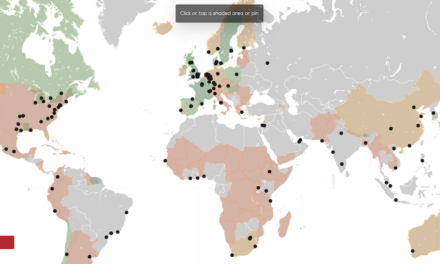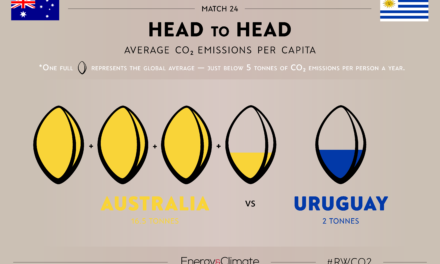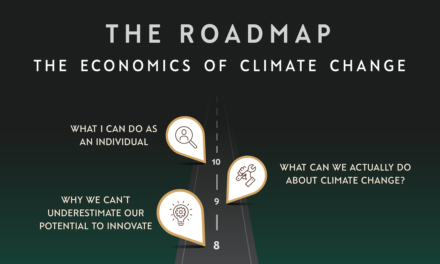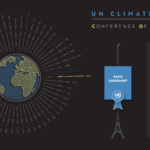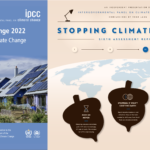Communicating climate change: Real-world challenges
BY BRONWYN LO
Bronwyn Lo moves past the psychological impediments and onto the real-world challenges. This is Part III of Bronwyn’s series on the challenges of communicating climate change in the digital age. If you missed the first two, here’s Part I and Part II.
At the start of this year, the polarising debate over climate change took centre stage in my country, Australia, as out-of-control bushfires swept across 17 million hectares and State and Territory borders to devastate lives, wildlife and livelihoods. With it, the tenacity of climate change misinformation and denial also came into clear light, against eerie orange skies and pitch black mornings.
While experts clearly stated that the bushfires were unprecedented and fuelled by climate change, the Australian public was deluged by claims – from some politicians, parts of the media and anonymous online sources – that arson and environmentalists (in blocking hazard reduction measures) were the main cause of the bushfires. Those claims were factually incorrect, but nevertheless were influential and widespread. Some government ministers minimised or denied climate change outright.
As natural disasters increasingly intrude on ordinary life, popular awareness of climate change is growing – but, as Australia’s situation shows, so too are ‘real-world’ challenges holding up action. I’ll explore some of those challenges further in this post. It’s also important to keep in mind, though, that while there’s a growing shift in public opinion toward climate change action (for example, in America, Australia and the UK), a significant proportion of the public is still on that journey – and awareness doesn’t necessarily translate into action.
To see why, let’s take a step back. Historically, studies on public opinion show a persistent gap between individuals’ expressed belief about climate change and their actions (the ‘value-action’ gap). This is one of the conundrums of climate change communication: the fact that individuals haven’t been motivated to act even when they express concern about climate change.
This is partly explained by issue priority. Climate change is only one of many concerns that a person may have. The priority that someone gives to climate change relative to their other concerns is therefore key, because actions – including political actions – follow priorities.
Yet climate change still struggles to gain priority over other issues that typically weigh on people’s minds, which in the policy context include health care, education, crime and the economy (see, for example, the UK study referred to here).
At the moment, climate change is competing with the coronavirus for attention. The world is focused now, rightly, on health impacts and responses to the COVID-19 pandemic. But it’s not pure competition, because climate change is expected to increase the risk of dangerous infectious disease outbreaks over time (see, for example, here and here). That COVID-19 coverage is largely silent on climate change isn’t surprising. First, there’s no suggested link between climate change and this outbreak. But more relevantly here, there remains low public understanding of the health impacts of climate change, including among health professionals. Why is this?
That’s where those real-world barriers to climate change understanding come in.
Challenge + 1: Speaking different languages
It’s unusual for an academic lecture to still be talked about decades on, outside as well as inside university halls. British civil servant and writer CP Snow’s lecture ‘Two Cultures’, delivered to a Cambridge audience in 1959, is unusual for its reach through time.
In this seminal lecture (later published in a book), Snow controversially argued that there was a growing divide between two disciplines that were central to his working life: science and the humanities. They had become like separate ‘cultures’, each with its own language, and each not open to or able to understand what the other had to teach. This divide, Snow said, had practical and moral consequences: it was detrimental to the western world’s intellectual life and its ability to solve society’s problems.
For one recent take on Snow’s ‘Two Cultures’, check out this wide-ranging conversation between Brian Cox, Stephen Fry and Robert May. (Warning: it’s 1.5 hours long!)
Sixty years on, gulfs – disciplinary and cultural – still exist, both within academia and across government, and between academia, policy makers and the general public. It’s seen in how different institutions and disciplines communicate not only with each other but also to the public on all-encompassing challenges like climate change. And, on the surface level, it’s reflected in different understandings of common terms.
This is problematic, because when it comes to climate change, words matter: different understandings of commonly used vocab can lead to misunderstanding and apathy.
Two examples are the concepts of ‘certainty’ and ‘likelihood’. In any area where non-experts must rely on the advice of experts, how experts communicate the state of knowledge in their area influences the perceived reliability of that advice.
In the case of climate change, climate scientists often express this knowledge in terms of ‘certainty’ about a conclusion, and their view of the ‘likelihood’ of a particular impact happening.
For instance, the UN’s widely-cited Intergovernmental Panel on Climate Change (IPCC) reports have concluded it’s ‘very likely that the frequency and duration of heat waves will increase’ due to climate change. The IPCC defines ‘very likely’ to mean 90-100% probability; but a study shows that non-scientists interpret this to mean closer to 70%, a much lower probability.
The story doesn’t end there, because these kinds of misunderstandings infect wider perceptions of climate change information. George Marshall points out that the general public tends to conflate technical uncertainty with everyday notions of uncertainty. Instead of accepting uncertainty as a natural part of the scientific method (as scientists do), the general public equates ‘uncertain’ with ‘unsure’, and interprets incomplete certainty to mean lack of confidence and reliability.
This all feeds into the psychology behind inaction.
Public understanding of climate change is a slippery landmark, and the path from learning to action isn’t linear; for a subject already psychologically challenging to grasp, alternative interpretations provide easy escape routes along the way.
Challenge + 2: The digital front
This problem is both exacerbated by and marginalised in the digital environment, with its bubbles, fragmentation, ‘fake news’, and attention wars.
The Internet has become a default source of information for many, including for the significant number who don’t fall within the extremes of climate change belief – those who are neither outright deniers nor highly engaged. In September last year, when the global climate strikes were kicking off, the top searches on climate change on Google were:
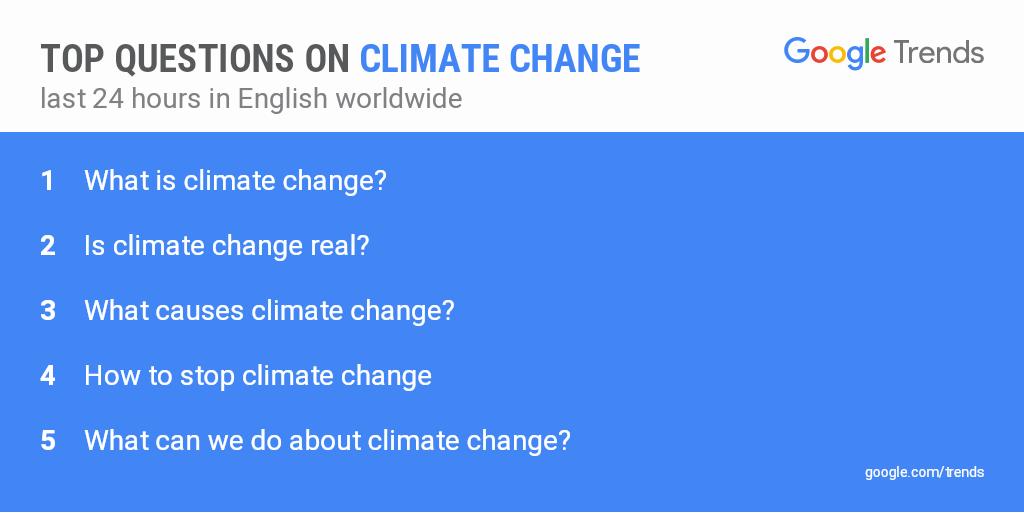
Credit: Google Trends
This suggests that many people who search for climate change information online are at an early stage in their engagement with the issue – in other words, they’re on their first step in moving further along the spectrum toward ‘Concerned’ or ‘Alarmed’. (For more context on this, see my previous post.)
But then and now, they would be confronted with an overwhelming task. Climate change information online has a few notable characteristics: it’s fragmented across sources and disciplines, time-consuming to wade through, fleeting (when it’s reported in the media), and of uncertain trustworthiness.
This is part intentional, part unintentional and part inevitable.
- Intentional, because there are individuals financially and/or ideologically opposed to government action on climate change who deliberately spread misinformation online to seed uncertainty in the public. (See the Merchants of Doubt and The Madhouse Effect for more on this.)
- Unintentional, because institutional and disciplinary silos promote a proliferation and fragmentation of information sources.
- Inevitable, because issues reporting and fact-checking are hostage to the speed of media and political cycles, shortened attention spans and multiplication of information sources.
There’s also another, more recent, factor driving this online landscape: recklessness. It’s important to note that misinformation can be unknowingly spread, and that it happens at both extremes of the belief spectrum. For example, as Michael E. Mann points out, when the ‘Alarmed’ become too alarmed, and misrepresent the science with doomsday scenarios, this can be as troubling for public understanding as denialism because they disengage the public with (outsized) fear and hopelessness.
The combined effect of all this is extreme noise, and potentially paralysis.
In 2007, academics at the University of East Anglia, UK, found that a key barrier to public engagement with climate change was ‘a lack of basic knowledge about [its] causes, impacts and solutions’. While information was available, they said, people didn’t necessarily translate it into knowledge or action for reasons including:
- lack of knowledge about where to find information;
- information overload;
- confusion about conflicting information or partial evidence;
- the format of information being inaccessible to non-experts; and
- the information source not being credible or trustworthy.
They concluded this before the rise of social media; now, over a decade on, these problems ring truer than ever.
What we end up with, then, is a significant number of people who are curious enough to search for climate change information, but not engaged enough to sift through the ‘noise’, or knowledgeable enough to withstand incorrect or contradictory information.
Support for this comes from the field of information science, which suggests that the early stage of information searching – ‘exploration’ – is when people are most vulnerable to abandoning their search due to confusion and uncertainty.
The psychological barriers that hold people back from accepting climate change as a priority issue – and from actively seeking out information about it – are, then, only the start of the challenge, and one part of what needs to be addressed. A messy, noisy, world places extra barriers in the way of understanding and action.
The next part of this series, Part IV, will look to ideas and initiatives: specifically, what is being done, and what could be done, to combat some of these real-world barriers?
